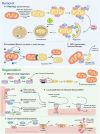PINK1 and Parkin mitochondrial quality control: a source of regional vulnerability in Parkinson's disease
- PMID: 32169097
- PMCID: PMC7071653
- DOI: 10.1186/s13024-020-00367-7
PINK1 and Parkin mitochondrial quality control: a source of regional vulnerability in Parkinson's disease
Abstract
That certain cell types in the central nervous system are more likely to undergo neurodegeneration in Parkinson's disease is a widely appreciated but poorly understood phenomenon. Many vulnerable subpopulations, including dopamine neurons in the substantia nigra pars compacta, have a shared phenotype of large, widely distributed axonal networks, dense synaptic connections, and high basal levels of neural activity. These features come at substantial bioenergetic cost, suggesting that these neurons experience a high degree of mitochondrial stress. In such a context, mechanisms of mitochondrial quality control play an especially important role in maintaining neuronal survival. In this review, we focus on understanding the unique challenges faced by the mitochondria in neurons vulnerable to neurodegeneration in Parkinson's and summarize evidence that mitochondrial dysfunction contributes to disease pathogenesis and to cell death in these subpopulations. We then review mechanisms of mitochondrial quality control mediated by activation of PINK1 and Parkin, two genes that carry mutations associated with autosomal recessive Parkinson's disease. We conclude by pinpointing critical gaps in our knowledge of PINK1 and Parkin function, and propose that understanding the connection between the mechanisms of sporadic Parkinson's and defects in mitochondrial quality control will lead us to greater insights into the question of selective vulnerability.
Keywords: Mitochondria; Mitophagy; PINK1; Parkin; Parkinson disease; Selective vulnerability; Substantia nigra.
Conflict of interest statement
TMD is a consultant for Mitokinin and owns stock options in the company. TMD and VLD are founders of Valted, LLC and holds an ownership equity interest in the company. TMD and VLD are founders and hold shares of stock options as well as equity in, Neuraly, Inc. These arrangements have been reviewed and approved by the Johns Hopkins University in accordance with its conflict of interest policies.
Figures


Similar articles
-
The role of PINK1-Parkin in mitochondrial quality control.Nat Cell Biol. 2024 Oct;26(10):1639-1651. doi: 10.1038/s41556-024-01513-9. Epub 2024 Oct 2. Nat Cell Biol. 2024. PMID: 39358449 Review.
-
Nix restores mitophagy and mitochondrial function to protect against PINK1/Parkin-related Parkinson's disease.Sci Rep. 2017 Mar 10;7:44373. doi: 10.1038/srep44373. Sci Rep. 2017. PMID: 28281653 Free PMC article.
-
Pink1, Parkin, DJ-1 and mitochondrial dysfunction in Parkinson's disease.Curr Opin Neurobiol. 2007 Jun;17(3):331-7. doi: 10.1016/j.conb.2007.04.010. Epub 2007 May 11. Curr Opin Neurobiol. 2007. PMID: 17499497 Review.
-
PINK1 and Parkin – mitochondrial interplay between phosphorylation and ubiquitylation in Parkinson's disease.FEBS J. 2015 Jan;282(2):215-23. doi: 10.1111/febs.13127. Epub 2014 Nov 20. FEBS J. 2015. PMID: 25345844 Free PMC article. Review.
-
PINK1 and Parkin complementarily protect dopaminergic neurons in vertebrates.Hum Mol Genet. 2013 Jun 15;22(12):2423-34. doi: 10.1093/hmg/ddt095. Epub 2013 Feb 27. Hum Mol Genet. 2013. PMID: 23449626 Free PMC article.
Cited by
-
Exploring Liraglutide in Lithium-Pilocarpine-Induced Temporal Lobe Epilepsy Model in Rats: Impact on Inflammation, Mitochondrial Function, and Behavior.Biomedicines. 2024 Sep 27;12(10):2205. doi: 10.3390/biomedicines12102205. Biomedicines. 2024. PMID: 39457518 Free PMC article.
-
The Nigral Coup in Parkinson's Disease by α-Synuclein and Its Associated Rebels.Cells. 2021 Mar 9;10(3):598. doi: 10.3390/cells10030598. Cells. 2021. PMID: 33803185 Free PMC article. Review.
-
The Multifaceted Regulation of Mitochondrial Dynamics During Mitosis.Front Cell Dev Biol. 2021 Nov 3;9:767221. doi: 10.3389/fcell.2021.767221. eCollection 2021. Front Cell Dev Biol. 2021. PMID: 34805174 Free PMC article. Review.
-
DNA Damage-Mediated Neurotoxicity in Parkinson's Disease.Int J Mol Sci. 2023 Mar 28;24(7):6313. doi: 10.3390/ijms24076313. Int J Mol Sci. 2023. PMID: 37047285 Free PMC article. Review.
-
Brain regions susceptible to alpha-synuclein spreading.Mol Psychiatry. 2022 Jan;27(1):758-770. doi: 10.1038/s41380-021-01296-7. Epub 2021 Sep 24. Mol Psychiatry. 2022. PMID: 34561613 Review.
References
Publication types
MeSH terms
Substances
Grants and funding
LinkOut - more resources
Full Text Sources
Other Literature Sources
Medical
Miscellaneous

